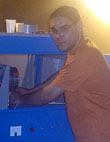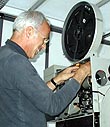|
|
 
|
|
Author
|
Topic: Portable Audio Set Up : Suggestions?
|
|
|
Luciano Brigite
Master Film Handler

Posts: 277
From: Sao Paulo, SP, Brazil
Registered: Jan 2002
|
 posted 08-06-2004 10:08 PM
posted 08-06-2004 10:08 PM




Will you use the system for anything else or just for film sound?
If it's only for film, a good processor with a set of power amps
neatly assembled inside a equipment case will do the work, remember that being in somewhat open spaces you'll need more power wich will calls for bigger amplifiers, making it heavy for transport. if the places you'll set it up aren't bigger than a average theatre, the same kind of amps will work, however , recreating the athmosphere of a theatre in an open place is harder to achieve.EQ'ing may become an issue then it'd be better a processor with a 1/3 eq per channel. you'll need an RTA and a pink noise card for setting it up .
Digital will add only one more equipment in the case and more cabling, I think digital processors (DTS,SR-D) are more sensitive to transport and may fail sooner than the analog due to their component soldering ( my oppinion tho..).
For speakers maybe another choice would be the ones designed for live shows (maybe it's the ones you're planning to use?) instead of theatre designed ones.
I have a set-up somewhat like the one you want, composed by a CP50 with upgraded cards + OBE and 3 power amps of 300W/channel + a spare amp. assembled in a metal/wood case. I use when I want to see a movie in my garage or then once in a theatre when someone messed it's sound rack and damaged the power amps and the processor's outputs, I put it to run there while repairing their system. my speakers are cheapo,unbranded ones,but does the work very well for me.
| IP: Logged
|
|
|
|
David Buckley
Jedi Master Film Handler
Posts: 525
From: Oxford, N. Canterbury, New Zealand
Registered: Aug 2004
|
 posted 08-07-2004 02:17 AM
posted 08-07-2004 02:17 AM





This is a budget question as much as anything. And how much bass you want (which is another way of saying how flat the bottom end of the system needs to be).
Conventional approach would be amps and speakers.
If you are shifting kit by air weight is important, so get amplifiers that have switch mode power supplies, sometimes called class D. A really good example is pulse amplifiers, which are widely used to drive array speaker systems. There is a 4 x 300w model, which might be ideal for what you require, and fit into 2u of rackspace. This means your processor and amps will fit into a gator case.
An alternative arrangement might be to use self-powered speakers, and thus not have separate power amps at all. Just distribute mains and line level audio.
I'm assuming you can get by with full range single amped speakers here. If this isnt the case then come back. In my opinion, as long as you are not clipping, then 300w is handle-able without biamping. If you go much above that, the economic and common sense case for biamping (or even 3x or 4x) starts to become stronger.
So I should state for the record that if are playing earthquate you will be disatisfied with the low end power of this sort of system. if you need earthquake, come back, and I'll add some more suggestions :-)
For room equalisation, you might choose something like the Sabine ADF4000 Power-Q Adaptive Audio Signal Processor. I've not tried this model, but it claims to auto-eq a room in 15 seconds, which is well faster than I've ever eq'd a space :-)
Just for clarity here; room eq is useful so that what the audience hears is not significantly impacted by the vagaries of venues that have nasty resonances, or tuned spaces that suck out specific frequencies. You still need to get the a-chain eq flat in the processor off the pink noise film loop, to account for the vagaries of the a-chain itself.
Another important question, given your desire for "cinema" sound, is dynamic range, especially in the context of the types of venues you will be playing in. Providing you have big enough amps, its easy to have enough headroom in a theatre to provide the "whisper to roar" dynamic range of modern film. In a gym, or any somewhere with not-quite-quiet enough air conditioning, low level dialogue may get lost below the venue's noise floor, and high level programme may end up clipping the amps, so you may (in fact, probably) need to reduce the programme's dynamic range. I dont know, but I would hope the dolby or smart processors could do this, as this is the most elegant place to compress. I dont think doing it ahead of the processor is a good idea 'cos you are compressing an encoded signal, and doing it after the processor is going to need a multichannel compressor; stereo is common but more than that is not, and thus would need some sidechain wiring bludge.
Caveat: I'm new to cinema, but old hand at sound reinforcement, and of the opinion that any half decent modern PA will be of at least as good a quality and capability as a typical cinema. Not necessarily better than the best cinema systems maybe...
| IP: Logged
|
|
|
|
|
|
|
|
|
|
All times are Central (GMT -6:00)
|
|
Powered by Infopop Corporation
UBB.classicTM
6.3.1.2
The Film-Tech Forums are designed for various members related to the cinema industry to express their opinions, viewpoints and testimonials on various products, services and events based upon speculation, personal knowledge and factual information through use, therefore all views represented here allow no liability upon the publishers of this web site and the owners of said views assume no liability for any ill will resulting from these postings. The posts made here are for educational as well as entertainment purposes and as such anyone viewing this portion of the website must accept these views as statements of the author of that opinion
and agrees to release the authors from any and all liability.
|

 Home
Home
 Products
Products
 Store
Store
 Forum
Forum
 Warehouse
Warehouse
 Contact Us
Contact Us




 Printer-friendly view of this topic
Printer-friendly view of this topic














